Category: Air National Guard
124th FW Airmen participate in weapons system evaluation program exercise at Hill AFB
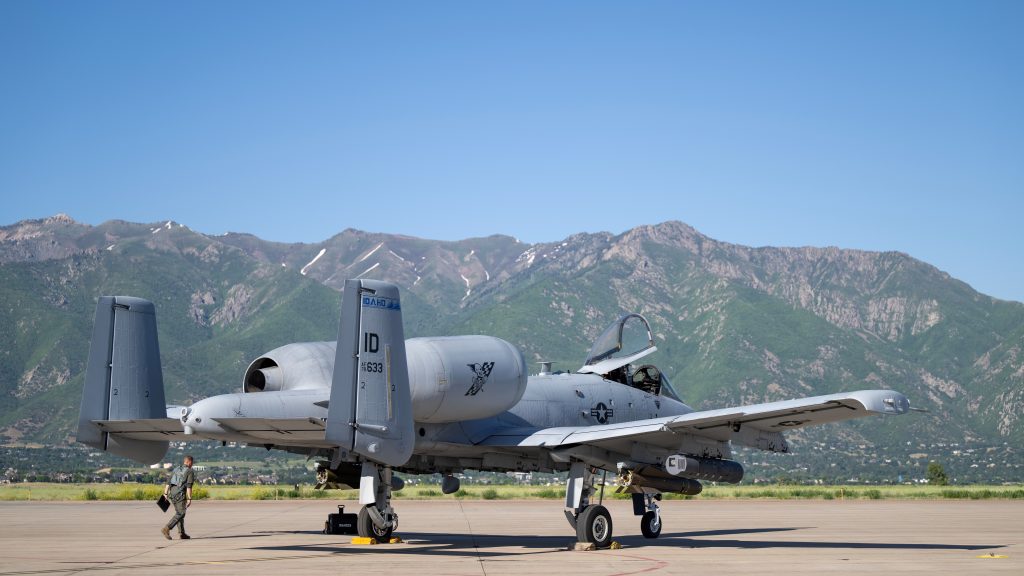
Airmen from the 124th Fighter Wing, Gowen Field, Boise, Idaho, participated in a weapons system evaluation program exercise at Hill Air Force Base, Utah, June 6-14, 2024.
The program is designed to test the employment of various live munitions and requires the efforts from various Air Force specialty codes, but focuses on the building, loading and employment of these munitions.
The use of lethal force is a serious burden and responsibility, requiring proficiency from everyone involved.
“This is a weapons training exercise,” said Staff Sgt. Alyssa Johnson, an aircraft armament systems technician with the 124th Aircraft Maintenance Squadron. “The focus is on how ammo builds munitions, how weapons loads them, and how the pilots drop them. The inspectors are making sure we are proficient at what we do.”
This is a unique and critical training event for Idaho Air Guardsmen.
“We don’t get a lot of opportunities like this in the Idaho Guard, because of where we’re stationed,” said Johnson. “Working with live munitions is critical for us.”
WSEP provides Airmen with challenges and opportunities.
“This has been a mini deployment,” said Tech. Sergeant Charles Updegraff, the senior munitions inspector for the 124th Munitions Flight. “We’ve worked long days and in a location with limited access to the equipment we normally have at home, challenging how we normally work.”
Updegraff went on to say that working through challenges prepares Airmen for real-world deployed scenarios, especially when looking at a near-peer fight. Allowing younger Airmen the opportunity to demonstrate their job proficiency and thinking on their feet, in a new and fast-paced environment.
Ammo Airmen weren’t the only ones to experience unique training opportunities.
“We had to drive all the way to the Dugway Proving Ground due to an issue with a stuck munition,” said Johnson. “You always hope that things go well, but sometimes things don’t. I was able to train on what we might experience when deployed, making sure that my crews and pilots are safe.”
Beyond the individual shop aspect of WSEP, ammo and weapons Airmen must work together to provide warheads for pilots.
“Here things are back-to-back and go, go, go,” said Johnson. “When we go downrange, ammo builds munitions; we load them, and the pilots drop them. This training prepares all of us to be successful.”
Johnson had one piece of advice when working to prepare to deploy, “There’s going to be days where things are good, and everything goes off as planned. Then there will be days where it’s more difficult. Maybe you don’t want to get out of bed, maybe it’s 100 degrees out, and you add another 30 degrees being on the tarmac. But being able to embrace the good and bad, and focus on the mission with your peers is amazing. We all get to build off each other’s energy and be able to build each other up. We’re exhausted, yes. We’re tired, but we help each other out, so that way, we’re all good in the end.”
Ultimately that is the most important takeaway when preparing for a future fight, working together, building each other up, and getting the mission done.
State, Guard Conduct Cyber Discovery 2024
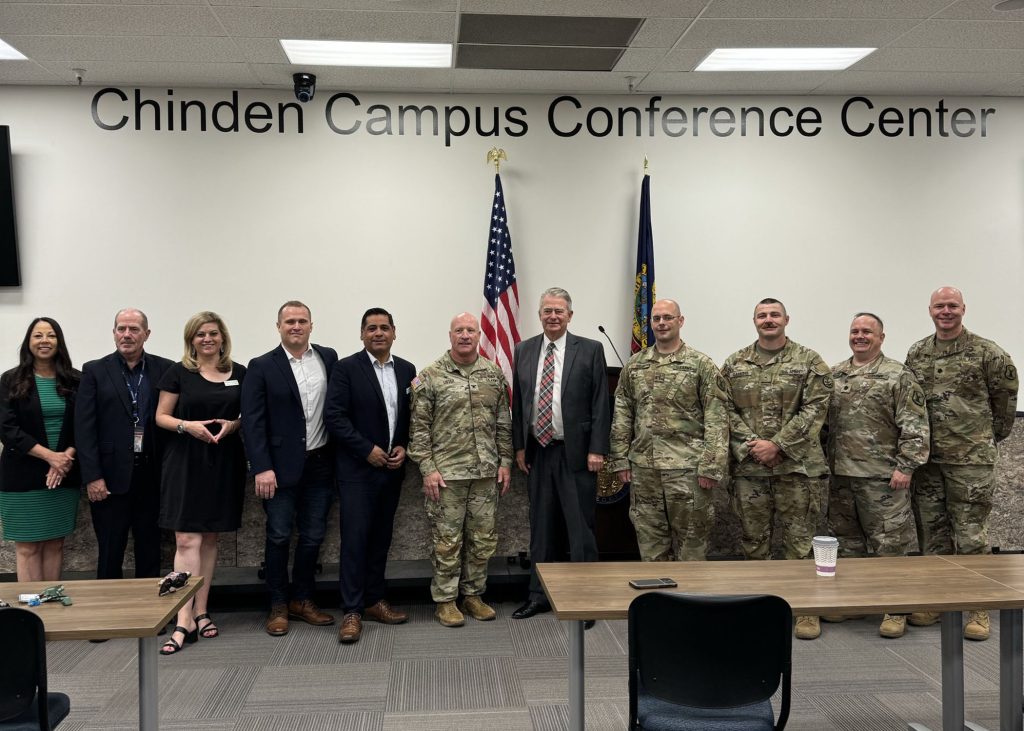
The Idaho National Guard and the Idaho Office of Information Technology Services recently hosted Cyber Discovery 2024 at the state’s Chinden Campus in Boise. Cyber Discovery is a regional cyber exercise focused on security operations, incident tracking and response. The exercise takes place within the framework of the Department of Defense’s Innovative Readiness Training program, enhancing its training value to both the state and Idaho National Guard while saving taxpayer dollars.
“One of the biggest benefits to conducting the training like this is that there’s minimal cost to either party,” said Col. Dan Lister, chief information officer for the Idaho National Guard’s Office of Information Management. “If you were to simulate this, you would be into the millions of dollars.”
During the exercise, 26 Guardsmen from Alaska, Idaho, and South Dakota Army and Air National Guards played the role of cyber threat actors while a team of 19 ITS employees, three Boise State cyber security program students and three Idaho Army National Guardsmen formed a defense team.
“We’re training to rapidly integrate Guard members for that cyber 911 that could come at any time,” said Chief Warrant Officer 4 Jerred Edgar, a defense cyber operations element officer with the Idaho National Guard. “We’re able to use the IRT to form and shape that response and rehearse it with our partners.”
Edgar said the ITS blue team made significant strides in threat detection, synchronized actions, and teamwork over last year’s performance in the exercise.
“Everything we do in these environments produces tangible results that the state can use to reduce cyber threats,” he said. “It’s process improvement, it’s building on efficiencies and identifying effective tools.”
The exercise provides exceptional training value to Guard members as well, said Lister.
“They’re training in a large-scale, real-world environment,” he said. “It really can’t be simulated and it’s very complementary to the skill sets they will use at various military echelon levels wherever they go in the world.”
Brig. Gen. Shannon Smith Selected as Assistant Adjutant General – Air
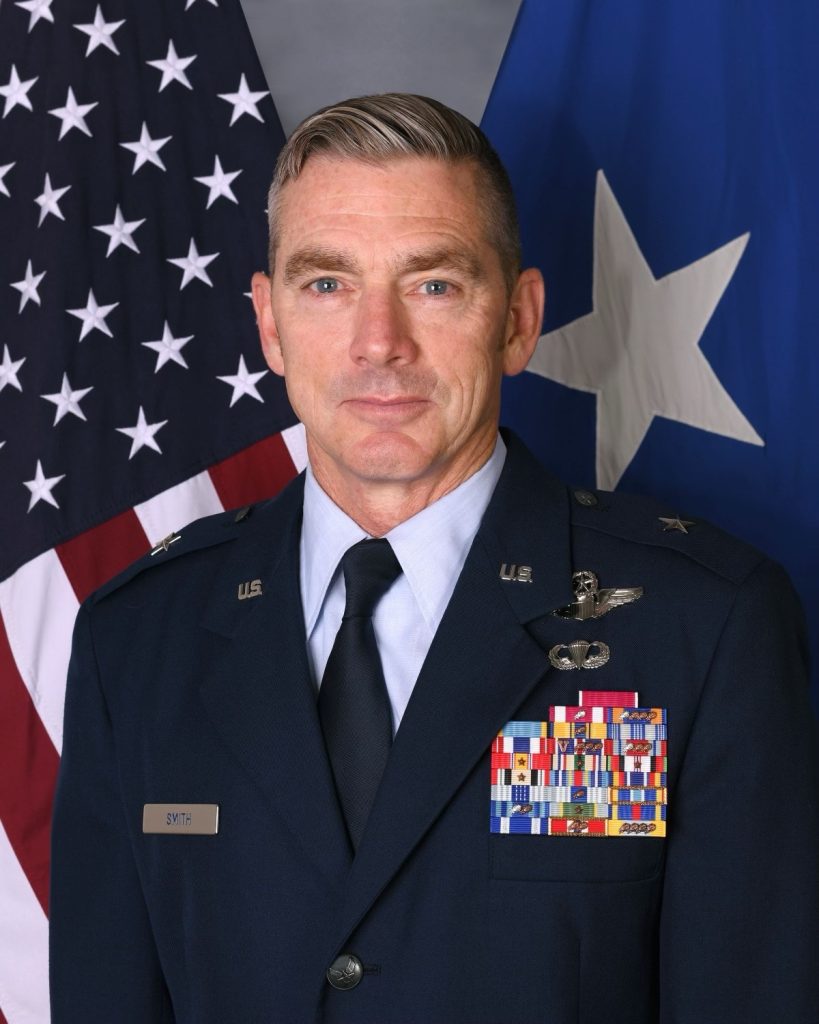
Maj. Gen. Timothy Donnellan is pleased to announce the selection of Brig. Gen. Shannon “Sinjin” Smith as the commander of the Idaho Air National Guard and assistant adjutant general- Air.
Smith replaces Donnellan in the same roles following Donnellan’s promotion to major general and appointment as adjutant general of Idaho and commander of the Idaho National Guard.
Smith previously served as the chief of staff of the Idaho Air National Guard, commander of the 113th Wing in Washington D.C., and commander of the Idaho Air National Guard’s 124th Fighter Wing. Smith has served in the Air National Guard since April 2002, following a decade in the active duty Air Force. As a pilot, he has logged more than 4,200 flight hours in his career and deployed to Afghanistan in support of Operation Enduring Freedom.
As the 124th Fighter Wing commander, Smith guided the wing through supporting the state’s response to the the COVID-19 pandemic while successfully conducting the wing’s second largest deployment in its history. During that 2020 deployment, the 124th Fighter Wing supported four named operations across 18 different locations, flying nearly 600 combat hours with no mishaps and a 100 percent weapons hit rate with no collateral damage.
Maj. Gen. Timothy J. Donnellan becomes Idaho’s 26th adjutant general
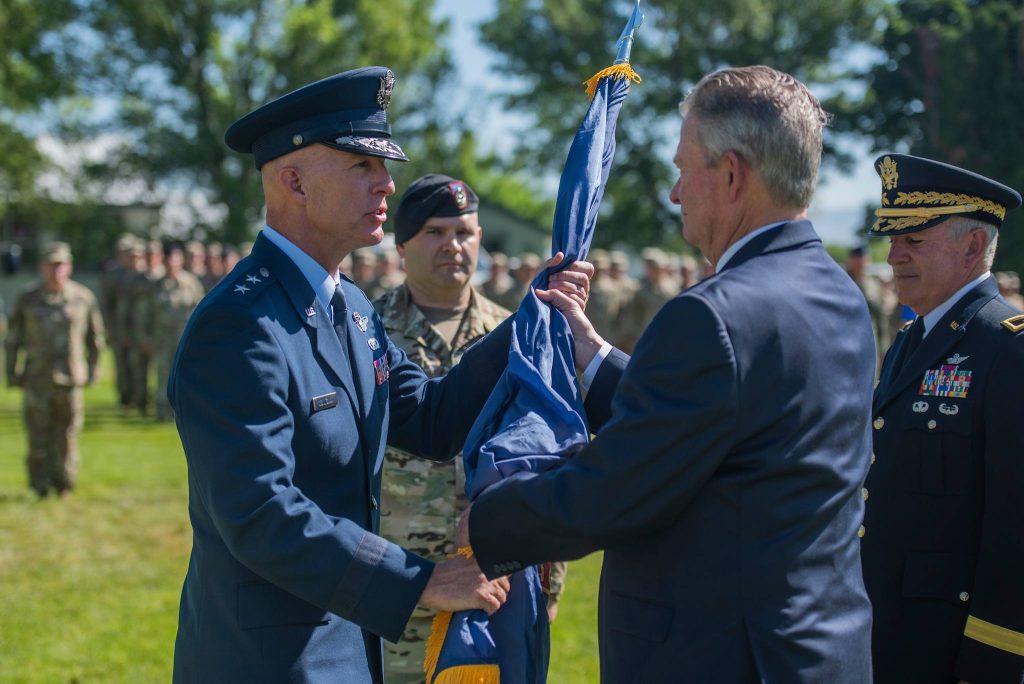
Idaho Medical Airmen Train in Field to Boost Readiness
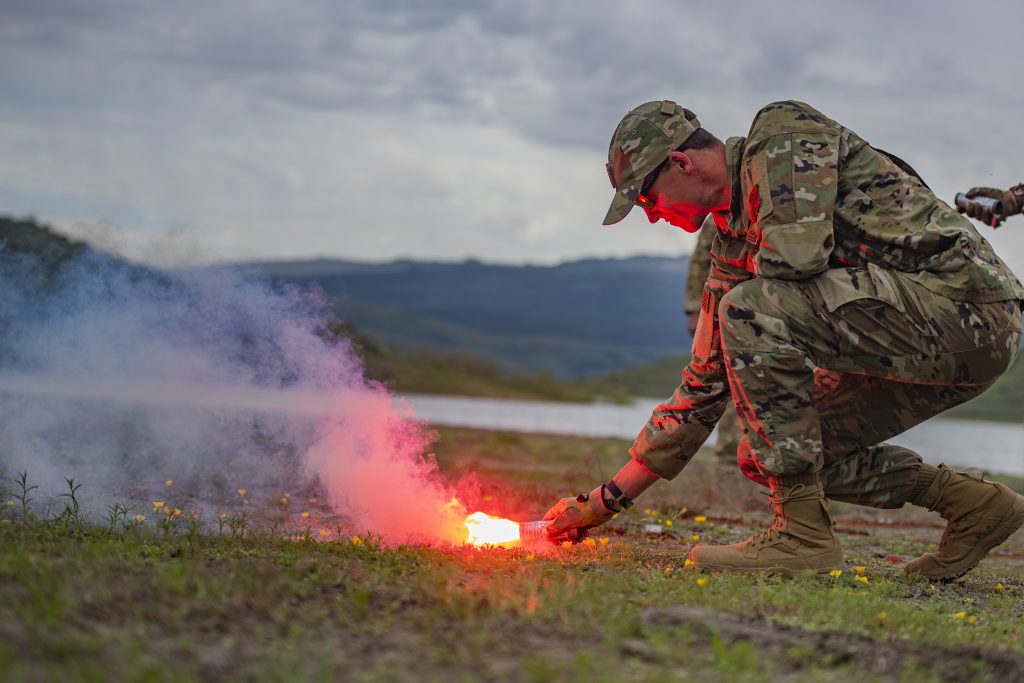
MOUNTAIN HOME, Idaho – Airmen from the Idaho Air National Guard’s 124th Medical Group trained in a field environment near Little Camas Reservoir in Elmore County June 5-8 to prepare for future deployments.
“The intent for this field training was to get the entire medical group exposed to the field environment for deployment readiness, as well as pushing comfort zones and team building,” said Maj. Mark Urban, critical care air transport team physician.
About 65 medical personnel practiced treating and stabilizing casualties using tactical combat casualty care in a simulated deployed location while defending medical structures and personnel.
Master Sgt. Raymond Perez, 124th Fighter Wing survival, evasion, resistance and escape specialist, trained the Airmen to survive in intense situations in unfamiliar surroundings.
“The medical teams will be geographically separated from the hospitals while deployed, functioning from a forward operating base,” said Perez. “I am training them on personal protection, clothing, building shelters, building fires, mental and physical health, environmental safety and protection, water purification and food sustenance. We are going to find food in the area, anywhere from vegetation on the ground to hunting animals that we will cook and eat.”
Medical personnel focused on tactical combat casualty care, point of injury, patient packaging, calling in a 9-Line medevac, patient movement, ground treatment and prolonged field care. Perez trained them on map and compass skills, signaling and recovery and making ground-to-air signals with flares for air rescue.
Idaho National Guardsmen, German JTACs reinforce relationships through training
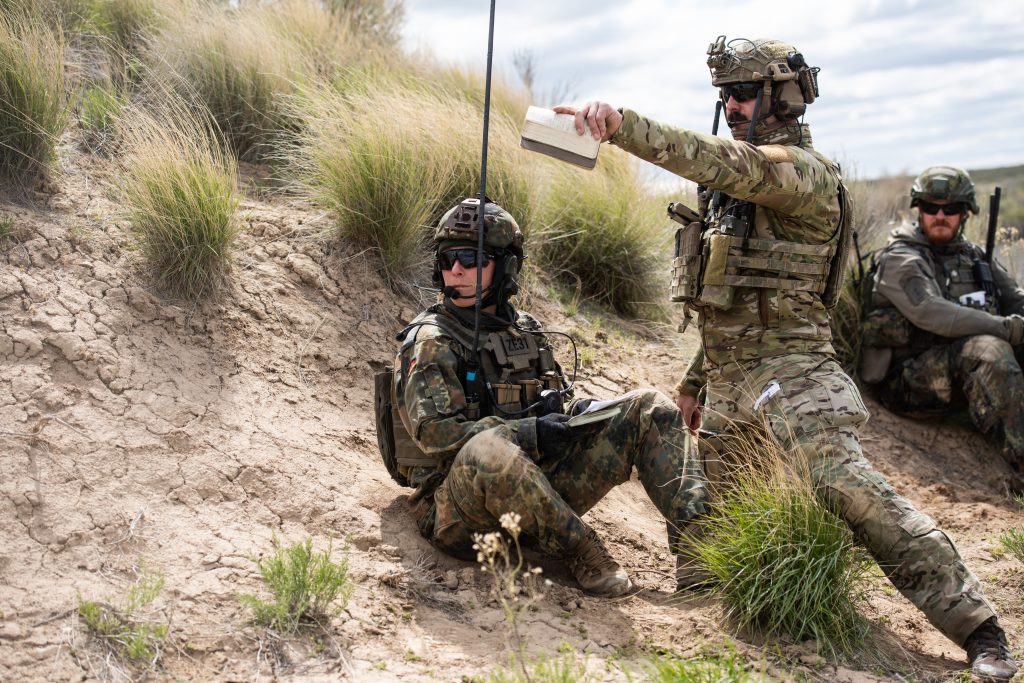
In 2015, an enlisted Idaho Air National Guardsman and a German Army lieutenant attended the same Joint Terminal Attack Controller Qualification Course and began a friendship that has had international implications for the past eight years. The two engaged in a series of conversations throughout their time at the course that resulted in a lasting partnership between the Idaho National Guard and the German military.
Master Sgt. Justin Clark, a senior airman at the time, is now a JTAC program coordinator with the 124th Air Support Operations Squadron. Clark said he immediately began looking for opportunities to bring the lieutenant’s unit to Idaho upon his return from the course. He said his unit commander’s support was key to guiding him through the process of coordinating and facilitating the German JTAC unit’s first visit to Gowen Field in the spring of 2016. The unit has returned every year since.
“The win, where it gets better every year, is the partnership,” said Clark. “We share lessons learned, and everyone’s experience culminates to make both parties better.”
This year, soldiers and airmen from Germany’s Joint Terminal Attack Controller Competence Center partnered with the Idaho Air National Guard’s 124th Fighter Wing to conduct close air support training at the Saylor Creek and Juniper Butte Ranges, Idaho, May 1-18. Idaho Army National Guard UH-60 pilots and crew also supported portions of the training, adding another layer of realism to the German troops training and further expanding their nearly decade-long partnership. The joint training incorporated NATO tactics, techniques and procedures, utilizing A-10 Thunderbolt II aircraft to prosecute targets ranging from armor, artillery, bunkers, simulated enemy combatants, moving targets, surface to air threats and more.
The visiting joint terminal attack controllers coordinate, integrate and direct the actions of combat aircraft engaging in close air support operations and joint fire observers, who augment JTACs by relaying target data. Leading them was Clark’s former classmate, Maj. Andreas Marx. Now a JTAC instructor himself, he said taking advantage of Idaho’s vast military range complex to enhance his unit’s training and further strengthen the international partnership is a win-win partnership.
“The CAS training opportunity that we have here, in conjunction with our partners from the 124th Fighter Wing is invaluable to us,” Marx said. “We do focus our training very much on large scale combat operations scenarios in the European theater of operations. Our partnership provides both sides with a common understanding and shared TTPs that will be of utmost importance during possible future conflicts with near-peer enemies.”
Located approximately 43 miles southeast of Gowen Field, Saylor Creek Range offers an impact area three miles wide by six miles long, where air and ground assets can employ live munitions.The Juniper Butte Range is located on 110,000 acres in southern Idaho and is covered with simulated hostile radar facilities, most of which are moveable electronic “threats. The range complex consists of two mock surface to air missile site targets in two strafe pits, a command site, a mock rail yard protected by two SAM sites, a radar/radio jamming tower and a range maintenance depot.
Master Sgt. Dennis Goettel, a joint fires platoon sergeant with the German Army, said the training site is unlike anything they have in Germany.
“In Germany, our soldiers never get into realistic situations like they do in Idaho because of training restrictions,” said the platoon sergeant. “It helps our soldiers to see live munitions hit their targets because then they know what they say to pilots really matters.”
In addition to the training, 124th ASOS Airmen and their German guests participate in other military exchange activities. This year, the units completed German and ASOS physical fitness assessments, and the Germans conducted shoot-and-move 9mm pistol and M4 carbine qualification courses for the Guardsmen.
Clark said the unit is expected to return to Gowen Field for another training event in August, when it will fully integrate with the 124th ASOS to conduct full mission profiles encompassing the squadron’s focus points – shoot, move, communicate, practice combat medicine and fitness.
Flyers Fueling the Fight: IDANG pilots refuel A-10s during training exercise
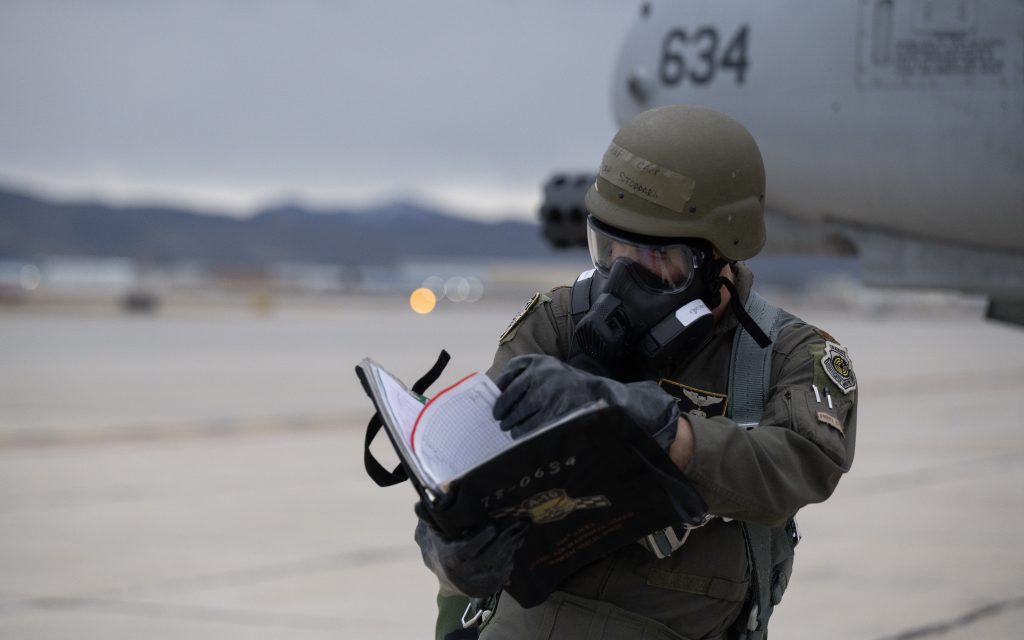
A-10 Thunderbolt II pilots from the 190th Fighter Squadron, part of the 124th Fighter Wing, Idaho Air National Guard, participated in a training exercise Feb. 1-2.
The pilots landed at Jocelyn Field, Magic Valley Regional Airport in Twin Falls, turned their own jets, and continued training exercises.
Landing at an airport that military pilots don’t use every day allows them to practice agile combat employment (ACE), which is a proactive and reactive operational scheme of maneuver to increase survivability while generating combat power.
“When thinking within this ACE concept, we may land in a place austere enough that there isn’t support by crew chiefs, especially A-10 trained crew chiefs,” said Col. Ryan Richardson, 124th FW deputy commander, “so pilots need to be familiar with how to service their own aircraft on the turns.”
The training exercise was designed to enhance agility and resilience, preparing for issues that may occur in a combat mission or high-threat environments, said Col. J.R. Williams, 124th Operations Group Commander.
“Specifically, the 124th Fighter Wing is testing command and control capabilities and concepts of operation while generating air power from different locations, all at a moment’s notice,” Williams said.
Although prior coordination with other military units, local airport authorities, and community partners took place, this simulated training mirrors what military aircrews might be faced with in a deployed environment.
“This is a 190th Fighter Squadron focused exercise,” said Richardson, “but we’re getting lots of support from other agencies.”
The IDANG pilots also practiced combat search and rescue with support from the Idaho Army National Guard’s UH-60 Black Hawks out of Gowen Field. Additionally, Navy EA-18G Growlers from Electronic Attack Squadron 135 in Washington integrated into some of the tactical training in the airspace. The A-10s were supported inside of the airspace by the 266th Range Squadron, an IDANG tenant unit located at Mountain Home Air Force Base in Idaho. They provided threat emitters to provide a realistic, contested training scenario.
“The flying training itself is similar to the training that we do daily, but the integration and the simulated war-time scenario of the exercise makes it more complex,” Richardson said.
A C-130 Hercules from the 152nd Airlift Wing, Nevada Air National Guard, also supported the exercise by transporting military members from Gowen Field to Twin Falls. Crew chiefs arrived at the regional airport and served as instructors for the pilots and as safety observers to make sure everything was done correctly.
“We’re proud and excited to be able to operate out of Twin Falls, and we’re grateful for the support of the airport,” said Richardson. “This is fantastic training that’s going to make us more capable in both our federal and our state mission. We are extremely fortunate to be able to get this kind of training in our backyard.”
Total Force: Army, Air, Navy train together in mass casualty combat exercise
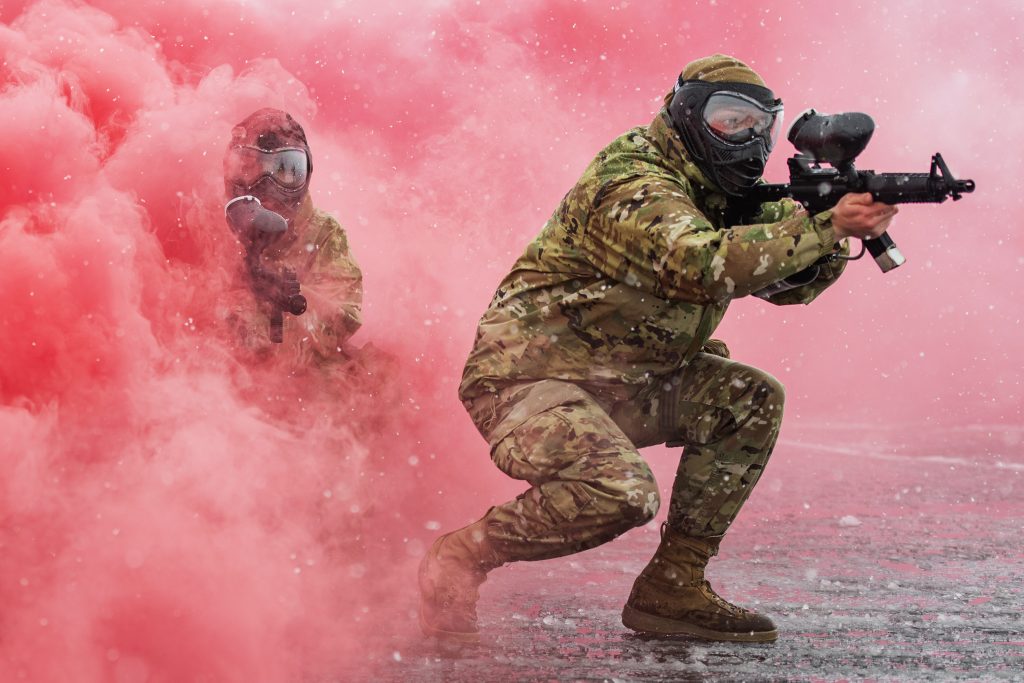
Master Sgt. Becky Vanshur/Idaho Military Division Public Affairs
BOISE, Idaho – A deep breath in, deep breath out. An Airman from the Idaho Air National Guard holds his weapon steady in front of him, pressing it against his shoulder, finger on the trigger, his body low to the ground. He takes a small, strategic step into the plume of smoke swirling around him. Surrounded by a blanket of red smoke makes it hard to see his battle buddy but he knows his counterpart, a Soldier from the Idaho Army National Guard’s Medical Detachment, is close behind him.
The red smoke is used to conceal the medical team’s movements as they defend their medical structures and personnel who are being ambushed while conducting Tactical Combat Casualty Care on the battlefield. The two Guardsmen were among approximately 200 Idaho National Guard Soldiers, Airmen and their active duty and Navy Reserve counterparts who joined forces for a mass casualty combat exercise, Feb. 1-4, near Gowen Field.
“The main focus of this joint services training was to all come together, learn each other’s jobs and create multi-capable Soldiers, Airmen and Sailors on top of learning how to respond in mass casualty scenarios,” said Senior Master Sgt. Davis Nguyen, the 124th Medical Group function area manager. “Equally important, was the ability to perform medical care while under mental and physical stress.”
The Idaho Air National Guard’s Critical Care Air Transport Team, the ground surgical team and other medical personnel from the 124th Medical Group conducted the exercise with the Idaho Army National Guard’s Charlie Company, 145th Brigade Support Battalion Medical Detachment and medevac Soldiers from the 1st of the 168th Aviation Regiment; the Navy Operational Support Center; and active duty Airmen with the 366th Medical Group from Mountain Home Air Force Base.
During the exercise, Soldiers, Airmen and Sailors learned each other’s roles on the battlefield and in the sky. The Idaho Army National Guard’s State Aviation Group incorporated UH-60 Black Hawk helicopters and pilots who responded to 9-Line medevac requests, transporting critical care patients with CCATT officers and medevac Soldiers who stabilized them onboard while flying through simulated combat zones until they reached a higher echelon of care.
“All of our pilots need to practice this piece of the exercise and learn how to fly with patients in the back,” said Chief Warrant Officer 3 Theron Cameron, instructor pilot and medical evacuation officer from the 168th Aviation Regiment. “We need to learn the CCATT’s language to know if they are in the middle of performing a procedure as it cues us to fly as smoothly as possible through the combat areas, while communicating back that we may need to aggressively maneuver around danger.”
Airmen from the 124th Fighter Wing’s Security Forces provided combat lessons on defense and protection, 360-degree security, care under fire and tactical movements with red smoke concealment.
Colin Yates, an Idaho Peace Officers Standards and Training instructor specializing in wounds and trauma for tactical medicine, created realistic wounds on 124th Fighter Wing’s Student Flight role players acting as casualties for a more real-world training experience of TCCC on the battlefield.
Sailors from the NOSC provided the medical logistics support for the simulated deployment location, while learning from both Army and Air medics on tactical field care, casualty evacuation and Roles 1-4 medical care facilities.
“It’s anticipated in future conflicts, there will be a lot more integration with forces. We need to interact with each other and speak each other’s languages,” said Maj. Mark Urban, CCATT physician. “This exercise was developed with that in mind, being able to integrate is really key to that Total Force concept.”
F-16 mission may be coming to Gowen starting in 2027
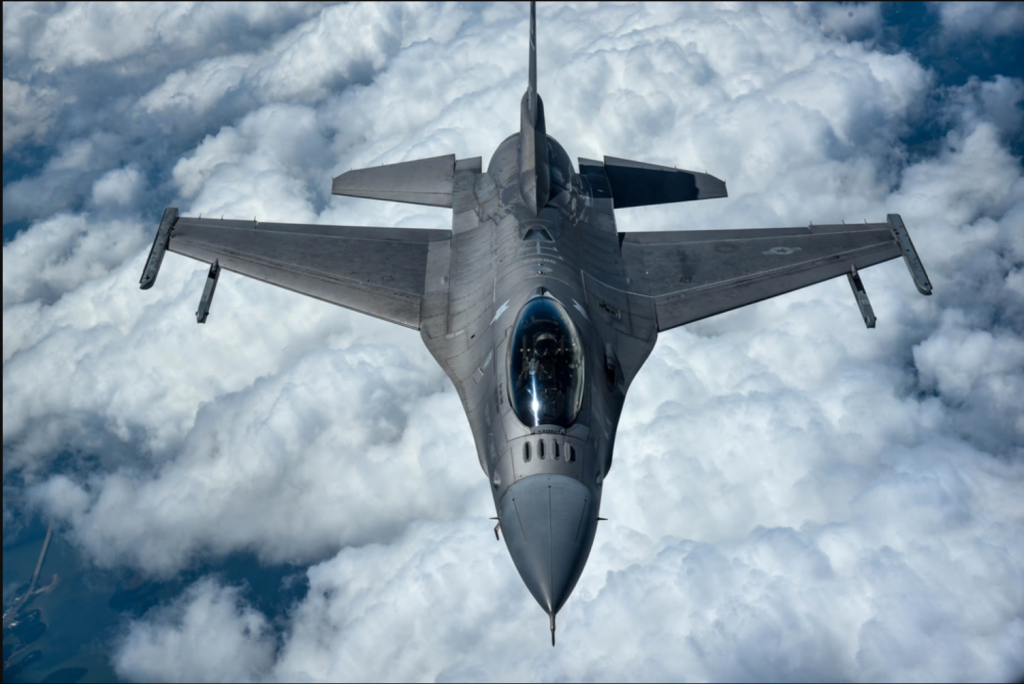
Photo by Tech. Sgt. Teri Eicher , 134th Air Refueling Wing
Gov. Brad Little and members of Idaho’s congressional delegation are proud to announce that the U.S. Air Force has identified the Idaho Air National Guard’s 124th Fighter Wing to potentially receive an F-16 Fighting Falcon mission at Gowen Field in Boise, Idaho.
F-16s are expected to begin arriving at Gowen Field in 2027.
“Idaho is proud of the critical role we have long played in supporting the nation’s defense strategy through the valuable work of the men and women serving at Gowen Field,” Gov. Little said. “The transition to the sophisticated F-16 mission at Gowen Field is the next step in the Idaho Air National Guard’s enduring commitment to safeguarding the liberties and freedoms we hold dear as Americans. This is an exciting step that will benefit the State of Idaho and the United States of America.”
The Idaho Air National Guard has maintained a fighter mission at Gowen Field for more than 75 years. This transition would replace the 18 A-10 Thunderbolt IIs that have been in service at Gowen Field since 1996. The one-for-one exchange would include the same number of F-16s, which are a more advanced and combat-effective aircraft.
The Air Force has planned to divest its aging A-10 inventory for more than a decade. Discussions have been ongoing among Idaho National Guard leaders, and local, state, and federal officials since 2012. Then, the Idaho Air National Guard was notified that their A-10 fleet was identified for divestment by 2015. However, events in Southwest Asia at the time extended the aircraft’s relevance just as the 124th FW embarked on the largest deployment in its history the following year. The 124th FW deployed again in 2020 marking its second largest deployment.
This modernization will better align the Air Force to support the current National Defense Strategy by leveraging the 124th FW’s existing fighter aircraft operations and maintenance expertise once the A-10s at Gowen Field are retired, beginning in the fall of 2026.
“Deterrence is a critical aspect of the National Defense Strategy,” said Brig. Gen. Tim Donnellan, commander of the Idaho Air National Guard. “Today’s near-peer adversaries like Russia and China remind us it’s imperative to ensure our personnel are trained and proficient with the best equipment and tools necessary to fight and win our nation’s wars.”
The Idaho National Guard expects a more detailed timeline from the Air Force in the coming months that will outline the next steps, such as the completion of an environmental impact analysis, planned for the spring of 2025.
The Idaho Air National Guard has been a fixture of the community since 1946. Since then, Idaho National Guard pilots have transitioned through 9 different types of fighter aircraft. With each new aircraft, the organization modifies its noise abatement procedures to minimize the impacts of jet noise on the community.
“Idaho National Guardsmen are rooted in every community in the state,” said Maj. Gen. Michael Garshak, adjutant general of Idaho. “When we are called upon, it’s your friends, families and neighbors coming together to support our community and our nation. Being good stewards of our environment is a priority and we will ensure Boise continues to be one of the most livable cities in the country, regardless of the aircraft we operate.”
Monday’s announcement from the Secretary of the Air Force would mean the continued viability of the Idaho National Guard. With more than $650 million dollars in annual economic impact coupled with nearly 8,000 jobs the Idaho National Guard creates, securing a follow-on fighter mission is a critical part of ensuring Idaho’s prosperity.
German soldiers train with Idaho Air National Guard A-10 pilots
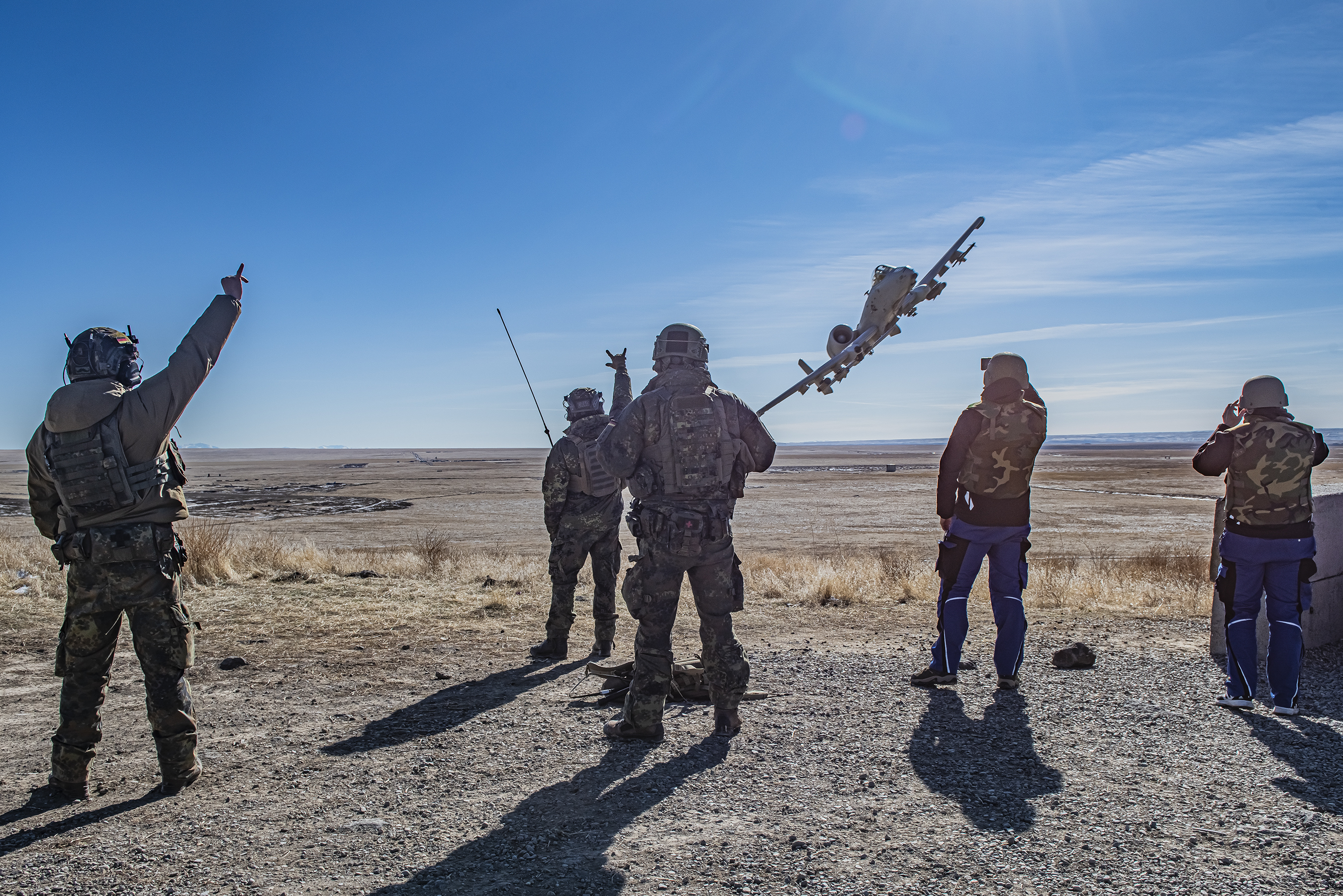
Soldiers from the German Army’s 6th Battery of the Artillery Battalion 345 joined forces with A-10 Thunderbolt II pilots assigned to the 124th Fighter Wing’s 190th Fighter Squadron Feb. 11 to 22, to conduct close air support training at Saylor Creek Range, Idaho.
“The 190th Fighter Squadron supports and encourages this training so we are prepared and familiar with our NATO counterpart’s tactics, techniques, and procedures,” said Lt. Col. Mike “Jack” Hampton, 190th Fighter Squadron commander. “The training also enables us to establish lasting relationships that we can rely on during times of war.”
The visiting soldiers from Idar-Oberstein, Germany, consisted of joint terminal attack controllers, who coordinate, integrate and direct the actions of combat aircraft engaging in close air support operations, and joint fire observers, who augment JTACs by relaying target data. The unit has trained in Idaho annually since 2016.
“The 190th accepts us here, dedicates training to us and improves our tactical training,” said a JTAC instructor from the German Army. “They honor our unit, and I am very proud in the trust that they set in us.”
The joint training between the Idaho Air National Guard and German forces incorporated NATO TTPs utilizing A-10 aircraft to prosecute targets ranging from armor, artillery, bunkers, revetments, aircraft, simulated enemy combatants, moving targets, surface to air threats and more.
“All of these target sets are incorporated into one training range, which delivers unmatched training compared to anywhere else in the world,” said Hampton. “Each training mission is complex and detailed to mirror any future conflicts in or around the European Theater but can also be used in any region of the world.”
Located approximately 43 miles southeast of Gowen Field, Saylor Creek Range offers an impact area three miles wide by six miles long, where air and ground assets can employ live munitions. A joint fires platoon sergeant with the German Army said the training site is unlike anything they have in Germany.
“In Germany, our soldiers never get into realistic situations like they do in Idaho because of training restrictions,” said the platoon sergeant. “Here you can be 500 meters away while a 2,000-pound bomb is flying off the jet. It helps our soldiers to see live munitions hit their targets because then they know what they say to pilots really matters.”
On the range, the German soldiers rehearsed various training scenarios to refine their procedures while both forces worked to hone their joint communication.
Later this year, members of the 124th Fighter Wing will deploy to Germany in support of Air Defender 2023.
 Official Government Website
Official Government Website